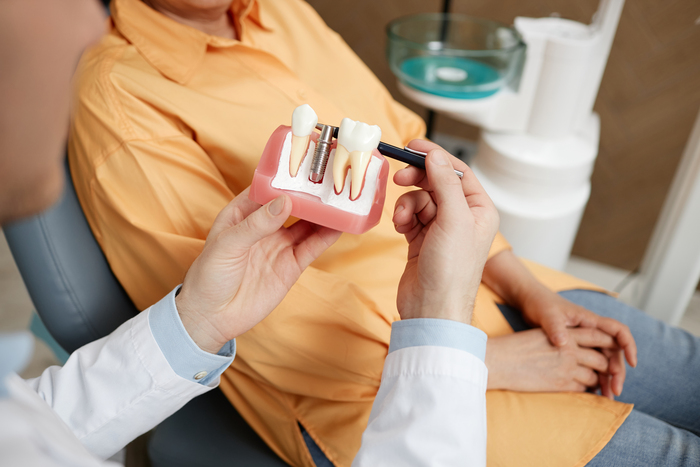What Is a Dental Implant?
A dental implant is a sophisticated dental device designed to replace missing teeth, according to the American College of Prosthodontists. They explain that dental implants offer a permanent and stable solution that closely mimics the function and appearance of natural teeth. It consists of three main components: a titanium post that is surgically implanted into the jawbone, an abutment that connects the post to the replacement tooth, and a crown that serves as the visible part of the tooth. The titanium post acts as an artificial tooth root, providing a strong foundation for the crown and promoting bone growth through a process called osseointegration, where the bone fuses with the titanium, according to the American College of Prosthodontists.
Dental implants are highly regarded for their durability, functionality, and aesthetic appeal, according to the American College of Prosthodontists. They explain that, unlike traditional dentures or bridges, implants do not rely on adjacent teeth for support and help preserve the integrity of the jawbone. This makes them an excellent option for individuals seeking a long-term solution to tooth loss that enhances both oral health and overall quality of life.
Types of Dental Implants
When considering dental implants, it is important to understand that there are different types designed to accommodate various dental needs and anatomical conditions, according to the American Academy of Implant Dentistry. They note that each type has unique characteristics that make it suitable for specific situations.
Below, we introduce the two primary types of dental implants and their distinct features, as listed by the American College of Prosthodontists:
Endosteal Implant
-
Most commonly used type of dental implant.
-
Surgically placed directly into the jawbone.
-
Typically made of titanium and shaped like small screws.
-
Ideal for patients with sufficient bone density and volume.
Subperiosteal Implant
-
Positioned on top of the jawbone but beneath the gum tissue.
-
Used for patients who do not have enough healthy jawbone and cannot or prefer not to undergo bone augmentation procedures.
-
Consists of a metal frame that fits onto the jawbone and protrudes through the gum to hold the prosthetic tooth.
Who Needs Dental Implants?
Determining whether a patient is a suitable candidate for dental implants involves a comprehensive evaluation by a dental professional, according to the American College of Prosthodontists. They explain that dental implants are a versatile solution for tooth loss, but not everyone may be an ideal candidate. Several factors must be considered to ensure the success and longevity of the implant.
Below are some key aspects that dentists evaluate when assessing a patient's eligibility for dental implants, according to the American Academy of Implant Dentistry:
-
Have a fully grown jawbone: Essential for providing a stable foundation for the implant.
-
Have enough bone in your jaw to hold the implant or are able to have a bone graft: Adequate bone density and volume are crucial for the implant's stability and integration.
-
Have healthy gum tissue with no periodontal disease: Healthy gums are necessary to support the implant and prevent complications.
-
Don't smoke tobacco: Smoking can impede healing and increase the risk of implant failure.
-
Are in good overall health: General health conditions can affect the healing process and the success of the implant.
-
Commit to good oral hygiene and regular dental visits: Maintaining oral health and attending follow-up appointments are vital for the long-term success of the implant.
Risks & Benefits of Dental Implants
Understanding the risks and benefits of dental implants is crucial for anyone considering this tooth replacement option, according to the American College of Prosthodontists. They explain that dental implants offer numerous advantages that can significantly enhance a patient's quality of life, but like any medical procedure, they also come with potential risks.
By weighing these pros and cons, patients can make informed decisions in consultation with their dental professionals. Below, we outline some of the key benefits and risks associated with dental implants, as outlined by the American College of Prosthodontists.
Advantages of Getting a Dental Implant
-
Long-lasting and reliable: Dental implants are designed to be a permanent solution, often lasting a lifetime with proper care.
-
Improved facial and bone features: Implants help maintain jawbone structure and prevent bone loss, which can preserve facial aesthetics.
-
Better ability to talk: Unlike dentures, implants do not slip, allowing for clearer and more confident speech.
-
Enhanced comfort and convenience: Implants feel and function like natural teeth, eliminating the discomfort and inconvenience of removable dentures.
Risks of Getting a Dental Implant
-
Infection at the implant site: As with any surgical procedure, there is a risk of infection, which can compromise the implant's success.
-
Nerve damage: Implant placement can potentially cause nerve damage, leading to pain, numbness, or tingling in the surrounding areas.
-
Sinus problems: For implants placed in the upper jaw, there is a risk of sinus issues if the implant protrudes into the sinus cavity.
-
Implant failure: Although rare, the implant may fail to integrate with the bone, necessitating removal and replacement.
How Much Does It Cost to Have Dental Implants?
When considering dental implants, one of the most important factors for many patients is the cost, according to the American College of Prosthodontists. They explain that dental implants are a significant investment in your oral health and overall well-being, and understanding the financial aspect is crucial for making an informed decision.
The cost of dental implants can vary widely based on several factors, according to the American Academy of Implant Dentistry. One of the primary determinants is the number of implants needed; a single tooth implant will be less expensive than multiple implants or a full-mouth restoration. Another significant factor is the need for additional procedures, such as bone grafts or sinus lifts, which can add to the overall cost. The choice of materials, the complexity of the case, and the geographic location of the dental practice also play a role in determining the final price, according to the American Academy of Implant Dentistry. On average, the cost of a single dental implant in the United States ranges from $3,000 to $5,000, according to the American Academy of Implant Dentistry. They note that this estimate includes the implant post, abutment, and crown, but additional costs may apply based on individual circumstances.
Does Insurance Cover Dental Implants?
Dental implant coverage varies significantly among insurance providers and plans, according to the American Academy of Implant Dentistry While some dental insurance plans may cover a portion of the cost, many consider implants to be a cosmetic procedure and do not provide full coverage. It is essential to review your insurance policy carefully and consult with your insurance provider to understand what is covered. Factors such as the reason for tooth loss, the necessity of the implant for oral function, and the specific terms of your policy will influence the extent of coverage, according to the American Academy of Implant Dentistry.
When seeking insurance coverage for dental implants, it is also beneficial to obtain a pre-treatment estimate from your dental provider, according to the American Academy of Implant Dentistry. This estimate can be submitted to your insurance company for a more accurate understanding of potential out-of-pocket costs. Additionally, some dental practices offer financing options or payment plans to help manage the expense of dental implants, making it easier for patients to access this beneficial treatment.
Dental Implant Process and Healing Stages
The dental implant process is a multi-stage journey that involves careful planning, precise surgical procedures, and a period of healing and integration, according to the American College of Prosthodontists. Understanding each step of the process can help patients feel more comfortable and prepared for what lies ahead. According to the American College of Prosthodontists, the step-by-step description of the average dental implant procedure, from initial preparations to the final placement of the new tooth, includes:
-
Initial Consultation and Assessment: The process begins with a thorough examination by a dental professional, including X-rays and possibly 3D imaging to assess the condition of your jawbone and plan the implant placement.
-
Bone Graft (if necessary): If there is insufficient bone density to support the implant, a bone graft may be performed to augment the jawbone. This step may require additional healing time before proceeding.
-
Placement of the Implant: During this surgical procedure, a titanium post is inserted into the jawbone. This post acts as an artificial tooth root and provides a stable foundation for the future crown.
-
Healing and Bone Growth (Osseointegration): Over the next several months, the jawbone will grow around the implant in a process called osseointegration, effectively anchoring the implant in place.
-
Healing Your Gums: After osseointegration, a minor procedure may be needed to expose the implant and attach a healing cap, which helps shape the gum tissue around the implant site.
-
Placement of the Abutment: Once the gums have healed, an abutment is attached to the implant. This connector piece will hold the new tooth (crown) in place.
-
Impressions for the Crown: Impressions of your teeth are taken to create a custom crown that matches the color, shape, and size of your natural teeth.
-
Placement of Your New Tooth: The final step involves attaching the custom-made crown to the abutment, completing the dental implant process, and restoring your smile.
-
Follow-Up Appointments: Regular check-ups are scheduled to monitor the implant and ensure it is functioning correctly, as well as to maintain overall oral health.
-
Long-Term Care: Proper oral hygiene and routine dental visits are essential for the longevity and success of your dental implant.
FAQs
What exactly is a dental implant?
A dental implant is a device designed to replace missing teeth. It consists of a titanium post implanted into the jawbone, an abutment, and a crown.
Are there different types of dental implants?
Yes, there are two main types: endosteal implants, which are placed directly into the jawbone, and subperiosteal implants, which are positioned on top of the jawbone.
Who is a suitable candidate for dental implants?
Candidates for dental implants need a fully grown jawbone, sufficient bone density, healthy gums, and good overall health. They should not smoke and must commit to good oral hygiene.
What are the potential risks and benefits of dental implants?
Benefits include durability, improved facial and bone features, better speech, and enhanced comfort. Risks include infection, nerve damage, sinus problems, and implant failure.
How much does it cost to get dental implants?
The cost varies based on factors like the number of implants needed, additional procedures, choice of materials, case complexity, and location. On average, a single implant in the U.S. ranges from $3,000 to $5,000.
Does insurance cover the cost of dental implants?
Insurance coverage for dental implants varies. It's crucial to review your policy and consult with your provider to understand your coverage.
What is the process for getting dental implants?
The process involves several stages, including consultation, bone graft (if necessary), placement of the implant, healing, placement of the abutment, impressions for the crown, placement of the new tooth, and follow-up appointments.
What are the benefits of dental implants?
Dental implants offer numerous advantages, including durability, improved facial features, and better speech.



